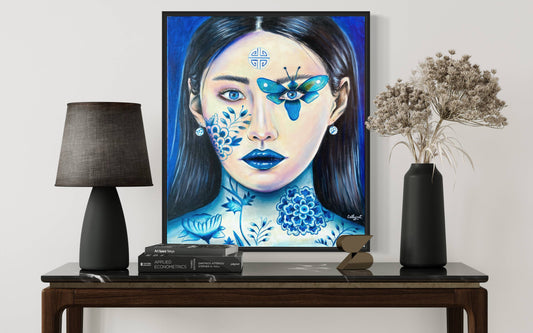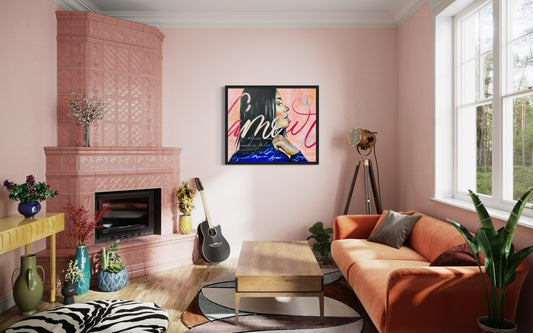
Choosing the right art for your space is more than just picking pieces that look good; it’s about setting the mood and creating an environment that reflects your personal style. Whether you're decorating your home, office, or any other space, the artwork you choose plays a critical role in shaping the ambiance. By considering factors such as color scheme, lighting, materials, and even using platforms like Pinterest or Instagram to gather inspiration, you can make informed decisions that enhance the mood of your space. Here’s how to choose the perfect art to set the right atmosphere.
1. Consider the Mood You Want to Create
Before selecting art, think about the mood you want to create in your space. Are you looking for something calming and serene, or do you want to energize the room with vibrant colors and dynamic compositions? Different spaces might call for different moods—perhaps a tranquil atmosphere in the bedroom, a lively and inspiring vibe in the living room, or a focused and productive energy in a home office. Identifying the desired mood will guide your choices in color, style, and subject matter.
2. Use Color to Set the Tone
Color plays a powerful role in setting the mood of a space. Soft, muted tones like pastels, blues, and grays can create a calm, relaxing environment, while bold, bright colors like reds, yellows, and oranges can add energy and warmth. Neutral tones like black, white, and beige can create a sophisticated, timeless look. When choosing art, consider how the colors in the artwork will interact with the existing color scheme of your room. If your space is already colorful, you might opt for art with more neutral tones to balance the room, or vice versa. The key is to ensure that the colors in the artwork complement the overall palette of the space.
3. Pay Attention to Lighting
Lighting is another crucial element in setting the mood of a space and can significantly impact how artwork is perceived. Natural light can enhance the colors and details of a piece, making it appear more vibrant. In contrast, artificial lighting, such as warm or cool-toned bulbs, can change the mood and feel of the artwork. When choosing art, consider how the light in your space will interact with the piece. For rooms with ample natural light, you might choose pieces with vibrant colors that will come alive in the sunlight. In spaces with more subdued lighting, softer tones or more abstract pieces might create a cozy, intimate atmosphere.
4. Select Art Based on Materials
The materials used in artwork can also influence the mood of your space. For instance, oil paintings on canvas often have a rich, textured feel that can add depth and warmth to a room. On the other hand, photography or prints on glossy paper might give a more modern, sleek look. Metal or glass artworks can add a contemporary, industrial vibe, while wooden frames or natural materials can bring warmth and organic elements into your space. Consider the overall aesthetic of your room and choose materials that enhance or complement it.
5. Scale and Proportion Matter
The size of the artwork you choose should be proportionate to the space where it will be displayed. Large pieces can make a bold statement and serve as the focal point of a room, while smaller pieces might work better in a more intimate space or as part of a gallery wall. Consider the wall space available and choose art that fits comfortably without overwhelming the room. Additionally, consider the furniture and decor in the room—art that is too small can get lost, while art that is too large can dominate the space.
6. Use Platforms Like Pinterest and Instagram
Platforms like Pinterest and Instagram are excellent resources for gathering inspiration and visualizing how different pieces of art can work in your space. Creating a mood board on Pinterest allows you to compile images of artwork, color schemes, and room designs that inspire you. Similarly, Instagram offers endless possibilities for discovering artists, trends, and interior design ideas. By curating a collection of images, you can see how different elements come together and make more informed decisions when choosing art for your space.
7. Create a Mood Board
A mood board is a powerful tool for planning the aesthetic of your space. It helps you visualize how different elements—art, furniture, color schemes, and textures—will work together. Start by collecting images of art that you’re drawn to, along with photos of your space, fabric samples, paint swatches, and other design elements. Arranging these on a mood board allows you to see how they interact and whether they achieve the desired mood. This process can help you narrow down your choices and ensure that the art you select fits seamlessly into your overall design.
8. Think About the Theme
Another factor to consider when choosing art is the theme of your space. A thematic approach can unify the different elements of a room and create a cohesive look. For instance, if your space has a coastal theme, you might choose art that reflects the ocean, beaches, or nautical elements. A modern, minimalist space might benefit from abstract art with clean lines and a limited color palette. By choosing art that aligns with the theme of your space, you create a more harmonious and aesthetically pleasing environment.
9. Consider Personal Connection
Art is deeply personal, and the pieces you choose should resonate with you on a personal level. Whether it’s a piece that reminds you of a special place, evokes a particular emotion, or simply reflects your taste, choosing art that you have a connection with can make your space feel more authentic and meaningful. This personal connection can also enhance the mood of your space, as the art will reflect your personality and experiences.
10. Don’t Be Afraid to Experiment
Finally, don’t be afraid to experiment with different styles, colors, and arrangements. Art is subjective, and what works for one person may not work for another. Try mixing different styles, such as modern and traditional, or experiment with bold colors in unexpected places. The key is to find what feels right for you and your space. By being open to experimentation, you might discover a unique combination that perfectly sets the mood you’re aiming for.
Conclusion
Choosing art for your space is an art in itself. By considering factors such as mood, color scheme, lighting, materials, and using tools like Pinterest and Instagram to gather inspiration, you can select pieces that not only enhance your space but also reflect your personal style. Whether you’re looking to create a calm, serene environment or a vibrant, energetic atmosphere, the right art can transform your space and make it truly your own. Remember, the most important aspect is that the art resonates with you and helps create the mood you desire.
Discover our original artworks and pop art contemporary portrait collection from Cathycat.


